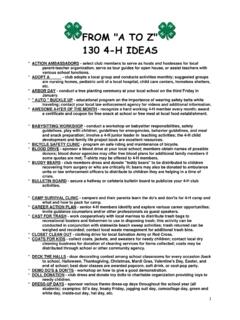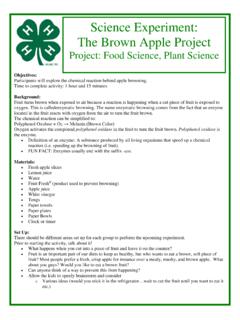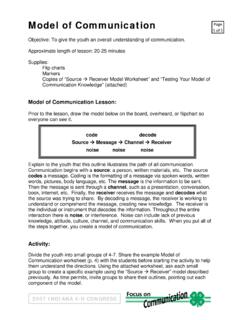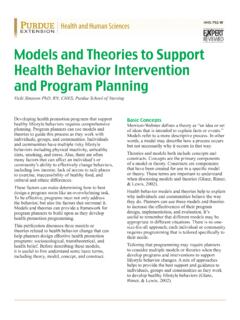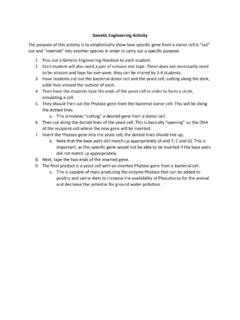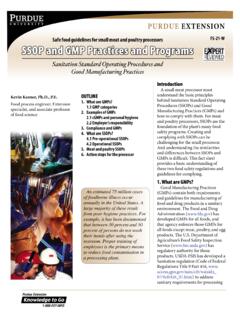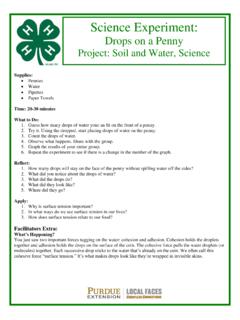Transcription of Communicating Effectively Lesson Plan
1 4-H-1001 Volume 2 New 1/08 4 " Communicating Effectively " Lesson Plan 2 Learning Objectives 1. To help youth communicate Effectively utilizing verbal and nonverbal skills. 2. To help youth identify parts of a speech. 3. To help youth build their communication skills through simple speaking opportunities. 4. To provide communication activities to be utilized at the 4-H Club meeting. Supplies & Resources Needed Lesson plan with instructional objectives Notes pages of PowerPoint presentation with talking points "Silent TV" activity. Supplies needed for this activity: o Ten minutes of a pre-recorded sitcom or 10 minutes of pre-recorded cartoon . o TV/VCR/DVD o Pencils/pens o Paper "Writing a Speech" activity.
2 Supplies needed for this activity: o Copies of 4-H Public Speaking - Writing a Short Speech, 1/2 page sheet for each participant (printed front-to-back) LCD projector and laptop with PowerPoint presentation loaded Copies of PowerPoint slides printed as a three-slides/page handout for each participant Copies of " Communicating Effectively " quiz for each participant Pencils or pens for volunteers to take notes and complete the quiz Copies of " Communicating Effectively " fact sheet References Conquering Fears of Speaking in Public (4-H 1001 Volume 1, 2007). 4-H Youth Development, West Lafayette, IN. Purdue University Extension Service. Picking Up the Pieces (4-H CCS BU-08156, 2005). National 4-H Cooperative Curriculum System, Inc.
3 Wiebers, Justin. Writing a Speech. The University of Tennessee Agricultural Extension Service. Jackson, Tom. Activities That Teach Life Skills. Projected Length Nonverbal Activity - 15 minutes Writing a Speech Activity - 10 minutes FORE! Activity - 10 minutes Total Lesson Length: 35-40 minutes 3 Instructor Notes Before starting this Lesson plan, it is recommended that you review the "Conquering Fears of Speaking in Public" Lesson Plan from the Volume 1, VolunteerIN 4-H Toolkit for Success to identify how to help youth understand what makes them scared of speaking in public. If you will be using the PowerPoint presentation to share this Lesson with the volunteers, set up the laptop and LCD projector prior to the start of the program and test the equipment to be sure it is working properly.
4 Welcome the group and thank them for their participation. Begin the Communicating Effectively PowerPoint presentation. Utilize the talking points found on the notes pages of the PowerPoint presentation to guide you during the presentation. Review the purpose and objectives for this Lesson plan. Provide a brief introduction of the Lesson , including its importance to the 4-H Youth Development Program. Proceed with the lecture portion of the Lesson . Distribute the " Communicating Effectively " fact sheet to each participant. Conclude the Lesson with a time for questions from the participants. Methods/Content Information found on Slides #1-2. Communicating Effectively One of the skills that we hope 4-H members are able to master is communication.
5 The communication skill will serve the 4-H members well as they proceed through their years in school and in the workforce. This Lesson includes several activities that can help 4-H members learn various communication concepts. Objectives To help youth communicate Effectively utilizing verbal and nonverbal skills. To help youth identify parts of a speech. To help youth build their communication skills though simple speaking opportunities. To provide communication activities to be utilized at the 4-H Club meeting. These are the objectives that we will discuss during this Lesson on Communicating Effectively . Objective 1 To help youth communicate Effectively utilizing verbal and nonverbal skills. Information found on Slides #3-4. What is nonverbal communication?
6 Body Language o Facial Expressions 4 o Eyes, Eye Contact o Arm Movement o Body Stance Are you able to read another person's body language? How do you communicate through your body? Facial expressions, eyes, eye contact, upper body movements, and a person's stance all influence how we interpret a nonverbal message. Information found on Slides #5-6. Nonverbal Activity - "Silent TV" Time: 15 minutes Introduction for instructors Gather the group around a television. Give everyone a sheet of paper and pencil. Watch five minutes of a pre-recorded sitcom that no one has viewed before. Now turn off the sound and watch for another five minutes. Have everyone write down what they think the actors are saying. Ask the group to describe what characters were saying and doing.
7 What were the nonverbal cues? (Write them down.) Develop everyone's idea into a script based on what they thought the characters were saying and act it out. Or watch the sitcom again with the sound on to see what the real verbal communication was and discuss the differences. You can do this activity again with a cartoon video. As you watch, analyze the differences between the cartoon and sitcom. Compare to see which nonverbal cues are easier (or harder) to follow. Your nonverbal skills are just as important to understand as your verbal skills. Silent TV is an activity that shows how we interpret different nonverbal clues. How do actions add to your understanding and enjoyment of conversations, cartoons, television shows, and movies? In this activity you will interpret nonverbal cues in a conversation by viewing a pre-taped sitcom.
8 We are going to watch part of a sitcom. For the first five minutes, we'll watch with the volume turned on. During the second five minutes, we'll watch without the volume. We want you to write down what you think the characters are doing and saying. Look for their nonverbal cues, and write down what you see. Ask the group to describe what the characters were saying and doing. What were the nonverbal cues? 5 Objective 2 To help youth identify parts of a speech. Information found on Slides #7-8. Use a hamburger to illustrate the three parts of a speech. First, the top of the burger is the introduction. Get the audience s attention (give a quote or surprising fact, ask a question, relate a personal experience, make an exclamatory remark, etc.) Make sure the audience knows what the speech is about.
9 Next is the meat the body of the speech. It is where you get into the importance of the topic. Without the meat, you don t have a hamburger. Without the body, you don t have a speech. List 3-5 main points you want to make about the topic. Add the bottom of the bun to complete the speech. Just as a hamburger would be pretty messy to pick up and eat without a bottom bun, so a speech should not be left hanging without a closing. Use the closing to review the main points, tell the audience what action you want them to take, and relate back to the introduction. An introduction, three main points in the body, and a closing are the basics. Be creative and add interest with the lettuce and tomato. For example, use descriptive words, use a visual theme throughout the speech, and change your speech using lots of expression to emphasize points and/or to create excitement.
10 Activity - "Writing a Speech" Time: 10 Minutes Information found on Slide #9. Writing a Speech Introduction You tell them what you re going to tell them. Body Tell them. Closing Then tell them what you told them. So, now we re going to give you a chance to try this yourself. Take a look at the cards you ve been given. This provides the basic outline for you to tell us about your favorite movie, color, friend, or sport. What else could you write about? [Give members a few minutes to work on speeches while going around to help and to encourage them.] Now, we all realize that a speech you would use for a contest would involve a lot more work and research, but let s hear what you ve put together in just a few minutes. Who wants to share what they have so far?
